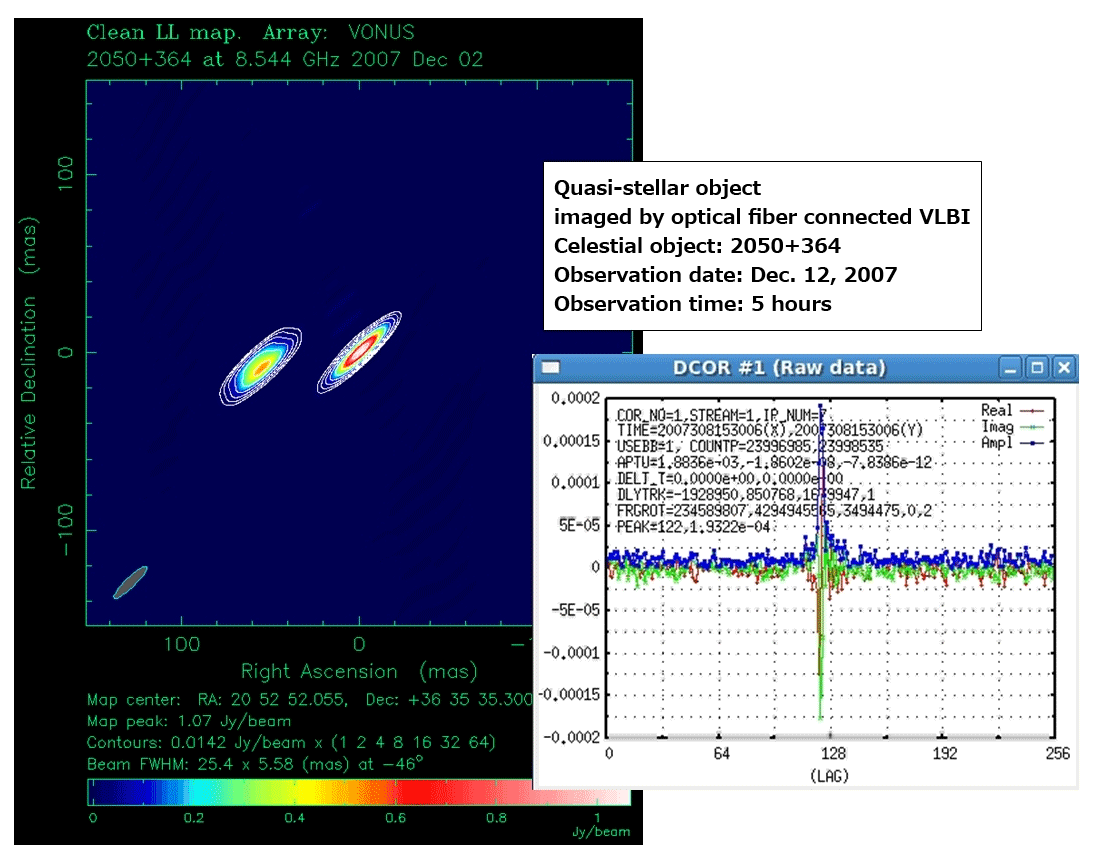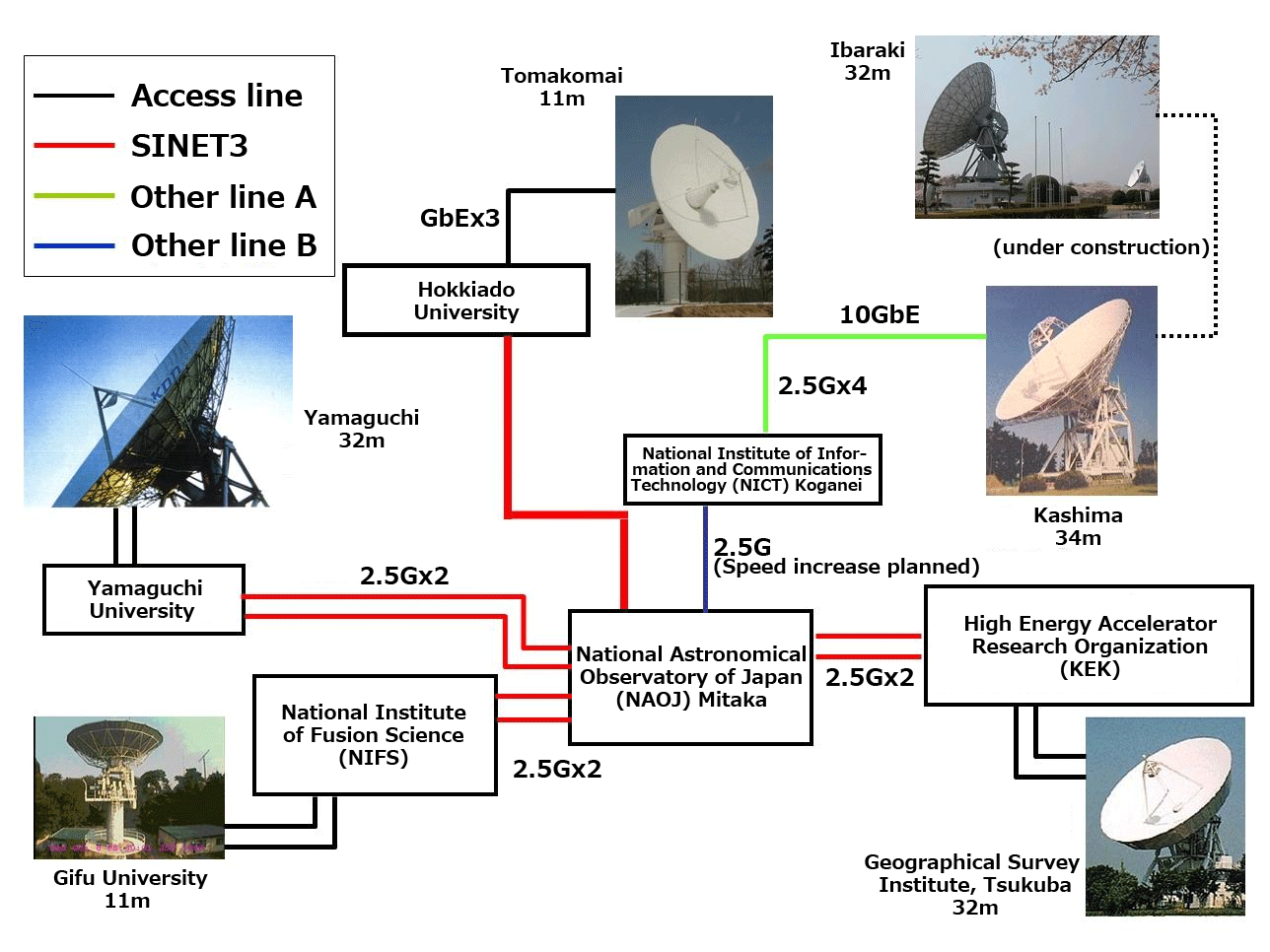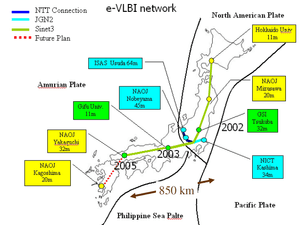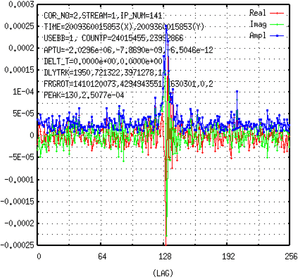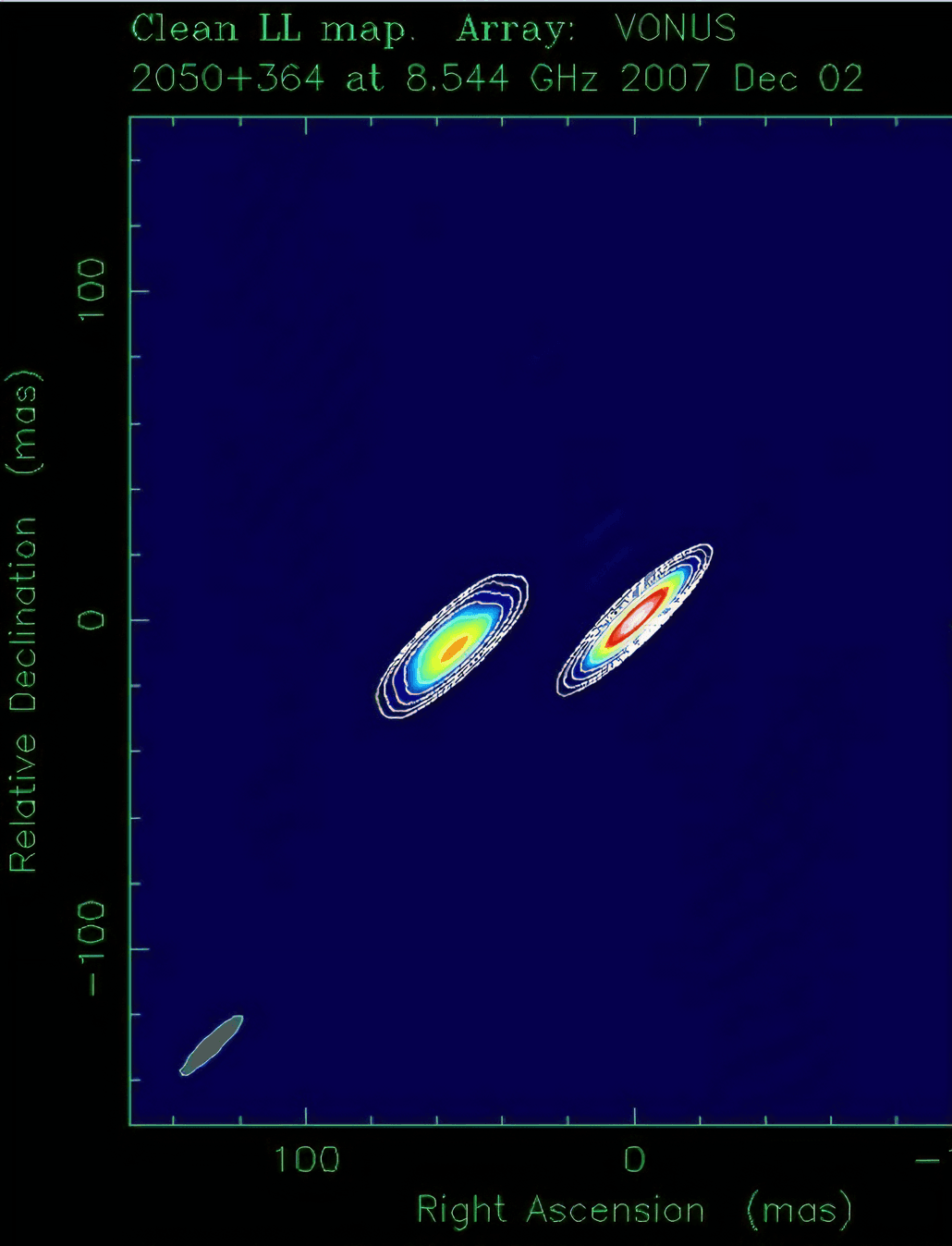
Optically Connected VLBI Observation Using SINET3 L1 On-demand Service
In the National Astronomical Observatory (NAOJ) of the National Institutes of Natural Sciences, the Optical Fiber Connected VLBI Promotion Office of the Mizusawa VERA Observatory operates a high-sensitivity observation network using optical fiber to link Japan’s VLBI stations. We talked with Professor Noriyuki Kawaguchi, head of the NAOJ Optical Fiber Connected VLBI Promotion Office, and Tetsuya Hara, researcher in the Office, about their activities to date as well as the benefits of the SINET3 L1 on-demand service, which they have recently begun using.
(Interview date: December 11, 2008; updated January 25, 2010)
Could you first give us an overview of the optical fiber connected VLBI your Promotion Office is engaged with, and its features?
Hara: Optical fiber connected VLBI (Very Long Baseline Interferometry) refers to technology that uses optical fiber to connect radio telescopes that are remote from each other, combining the observation data from each telescope to enable higher-sensitivity observations. In early VLBI observations the data was recorded on magnetic tapes, which were then sent to the correlator station for correlation processing. It took a great deal of time and effort before the results could be obtained. With optical fiber connected VLBI observation, the data is sent immediately over a network for processing in real time. Moreover, since the amount of data exchanged is no longer limited by the capacity of magnetic tapes, it is now possible to observe celestial objects that could not be observed before.
Over the years there have been a number of different projects preceding this one, right?

Kawaguchi: That’s right. Looking back, the Key Stone Project carried out in the 1990s by the Communications Research Laboratory (currently the National Institute of Information and Communications Technology [NICT]) paved the way for the full-scale optical fiber connected VLBI era. Around the same time, NAOJ in collaboration with the Institute of Space and Astronautical Science (now JAXA) and NTT launched the OLIVE Project, performing real-time correlation of VLBI observation data sent via the Halca satellite. These two projects were merged in 1998 and re-launched as the GALAXY Project.
Then when Super SINET service was begun, the VONUS Project was started up in 2002. In this project, first of all the 32m antenna of the Geographical Survey Institute in Tsukuba was connected via the High Energy Accelerator Research Organization (KEK), and later the Gifu University 11m antenna was connected via the National Institute for Fusion Science (NIFS). After SINET3 service began, the NAOJ 32m antenna in Yamaguchi was connected via Yamaguchi University. Then in 2006 the GALAXY and VONUS networks together were migrated to the OCTAVE Project, resulting in one of the world’s most advanced optical fiber connected VLBI networks.
In the case of optical fiber connected VLBI, isn’t it true that the greater the bandwidth, the better?
Kawaguchi: Certainly. VLBI observation searches for similarities among the observation data from each of the radio telescopes. This is called correlation processing. The issue here is the percentage of the portions that are similar. Of the data received by a radio telescope, only about 0.01 percent is usable as observation data. In fact, that’s on the high side, and the remaining 99.99 percent or more is noise.
I like to compare this to mining for gold dust, and in order to find some gold dust you need to gather a lot of sand. It’s the same with optical fiber connected VLBI. Observation requires gathering very large amounts of interferometry data. Even the current observation system produces enough data to fill up 8Gbps of bandwidth easily, but a recently developed system is capable of sampling at 50GHz. When this system comes into practical use, theoretically the bidirectional data size will be 100Gbps, so we will have no problem using as much bandwidth as you can provide. (laughs)
Recently you have started using SINET3 L1 on-demand service. What is your aim here?
Kawaguchi: Radio telescopes operated by organizations other than NAOJ have their own individual missions. We can only use these sources during a specified period of time to obtain meaningful observation information because unless all radio telescopes are pointing at the same celestial objects, we cannot observe them. Yet even when these observations are not taking place, data is being carried on the network round the clock, 365 days of the year, taking up the bandwidth with useless data. This is a problem that had been worrying us for some time.
By using the SINET3 L1 on-demand service, however, we can limit the allocation of network resources to the times we are actually performing observations. This is a really good idea, and the first time in the world for such a service to be provided on a scientific network.
What are your impressions from having actually used the service?
Hara: We are running an L1 path between the Yamaguchi 32m antenna and Tsukuba 32m antenna. The procedure for reserving a path is very simple and the service is easy to use. Ordinarily we make reservations a few days before the observations, but when we want to use it right away we can make same-day reservations, which is very convenient. Just today we have made a reservation for observations that will take place a few days from now.
Are there times when your reservations conflict with those of other universities or institutes?
Hara: This hasn’t been a problem yet, since the service is still in the trial use stage; but it could happen once official service is started. Of course many of our observations take place on weekends, so we have less worry than other users about possible schedule conflicts. When there are multiple requests for the same time span, the L1 on-demand service provider decides by lot, and the results are displayed on the screen. So far we haven’t really tasted defeat. (laughs) For our latest reservation, incidentally, we have reserved a four-day period including Saturday and Sunday, and plan to conduct two sets of observations during the time from 9:00 a.m. to 4:00 p.m
Do you plan to increase the number of connected sites?
Hara: In 2009 we have connected the Hokkaido University Tomakomai 11m antenna via the university’s Sapporo campus, and will also be connecting the NAOJ Hitachi 32m and Takahagi 32m antennas in Ibaraki Prefecture. The ability to carry out long-term, high-sensitivity observations has increased the potential for making brand new discoveries. It is the network that really makes possible this research. I very much look forward to achieving good results and introducing them to the world.
Finally, what are your expectations of SINET?
Kawaguchi: Right now we are involved in connecting together radio telescopes throughout Japan, but there are many more radio telescopes in other countries outside Japan. In the future we would like to connect radio telescopes throughout the world by optical fiber. Naturally, SINET support is essential for realizing this kind of global observation network, so we hope you will continue striving hard to provide good service.


